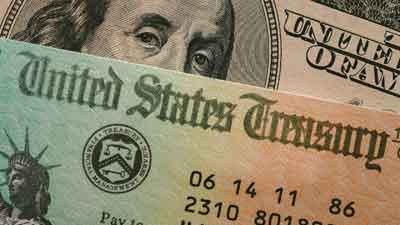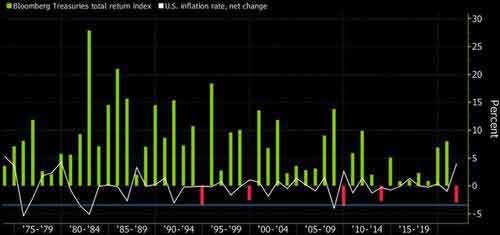Bond Market Crash Will Surprise Only The Uninformed
Tyler Durden
 A global bond market meltdown is only a matter of time. One fine morning, traders will wake up to find all benchmark yields sharply higher, 10 to 20 basis points or more, and no buyers around. A global bond market meltdown is only a matter of time. One fine morning, traders will wake up to find all benchmark yields sharply higher, 10 to 20 basis points or more, and no buyers around.
Bond price indicators are flashing deep red right now, from decade-high inflation expectations to waning auction demand and whispers of depressed liquidity. Last week, the U.S. 5-year breakeven rate briefly topped 3% for the first time since the maturity was restarted in 2004
Bloomberg’s U.S. Treasury index is on track for its worst annual loss since 2009, and that’s only the beginning. Expect the Treasury 10-year yield to top 2%, Bunds to end their two-year trek in the sub-zero wilderness and Gilts to continue pushing higher toward levels last seen in 2018.

It’s not a taper tantrum. The time for that passed months ago, and the Fed’s well-telegraphed intention to start slowing its $120 billion monthly bond purchases at next week’s meeting is all baked in.
Bonds will collapse on investors’ delayed realization that inflation is here to stay, and won’t be tamed without serious policy tightening.
Equally serious concern stems from the fact that a big part of the recent inflation spike is supply-shock driven. Conventional policy tightening would do little to resolve supply-chain problems, leaving policy makers unable to directly influence rising prices.
If all that sounds unrealistic, or just a mere tail risk scenario, consider this: wagers for Bank of England rate hikes over the next year have been ramped up to more than 100 basis points in only a few weeks. A Hundred basis points! Saying that aloud would have been seen as a joke as recently as early September.
Perma-bulls often point out that yields fell following the 2013 taper tantrum. That is correct, but it only happened after the Treasury 10-year yield had surged about 140 basis points in four months and took well over a year to return to where it was before the selloff. A similar move now from August lows would take Treasuries above 2.5%.
The biggest difference is in the macro backdrop. In 2013, the headline U.S. inflation rate was well below 2% -- it’s been over 5% for five months now. The ISM index of prices paid for inputs is hitting levels not seen for a decade and the inflation expectations of the University of Michigan consumer survey are the highest since 2008.
Everyday consumer items are only about to get more expensive amid stubborn supply-chain disruptions. There’s an energy crunch brewing in many of the developed economies and crude oil appears more likely to hit $100 than fall back toward $50.
Fed Chair Powell on Friday said that “risks are clearly now to longer and more persistent bottlenecks”. Other Fed officials have earlier acknowledged that “transitory” has become a dirty word. And the global financial commentariat is now more often talking about “policy error.”
Treasury yields are now almost exactly where they were just before the 2013 taper tantrum or the 2016 reflation trade following Trump’s election victory. In both cases, yields eventually topped 3%.
Portfolio holders suddenly find themselves bracing for potentially massive losses. Duration hedging will only work to drive bond prices lower. The dollar should benefit from the dual tailwind of higher U.S. yields and haven demand.
Risk assets won’t be able to ignore severe bond market carnage. Earlier this year, when 10-year Treasuries were testing 1.70%, the S&P 500 index retreated about 5% before resuming its rally. Investors shouldn’t count on such a benign reaction this time. Wall Street near records and the VIX at its lowest since the pandemic started show that stocks are hopelessly unprepared for tighter funding conditions.
It’s not all gloom. Previous cycles have shown that the world economy can handle higher borrowing costs. Equities may even see firmer yields as a sign of a strong economy. But there’s no denying recalibration to higher yields after years of ultra-low rates will be a painful exercise for those not ready for it.
 our mission: our mission:
to widen the scope of financial, economic and political information available to the professional investing public.
to skeptically examine and, where necessary, attack the flaccid institution that financial journalism has become.
to liberate oppressed knowledge.
to provide analysis uninhibited by political constraint.
to facilitate information's unending quest for freedom.
our method: pseudonymous speech...
Anonymity is a shield from the tyranny of the majority. it thus exemplifies the purpose behind the bill of rights, and of the first amendment in particular: to protect unpopular individuals from retaliation-- and their ideas from suppression-- at the hand of an intolerant society.
...responsibly used.
The right to remain anonymous may be abused when it shields fraudulent conduct. but political speech by its nature will sometimes have unpalatable consequences, and, in general, our society accords greater weight to the value of free speech than to the dangers of its misuse.
Though often maligned (typically by those frustrated by an inability to engage in ad hominem attacks) anonymous speech has a long and storied history in the united states. used by the likes of mark twain (aka samuel langhorne clemens) to criticize common ignorance, and perhaps most famously by alexander hamilton, james madison and john jay (aka publius) to write the federalist papers, we think ourselves in good company in using one or another nom de plume. particularly in light of an emerging trend against vocalizing public dissent in the united states, we believe in the critical importance of anonymity and its role in dissident speech. like the economist magazine, we also believe that keeping authorship anonymous moves the focus of discussion to the content of speech and away from the speaker- as it should be. we believe not only that you should be comfortable with anonymous speech in such an environment, but that you should be suspicious of any speech that isn't.
www.zerohedge.com
| 



